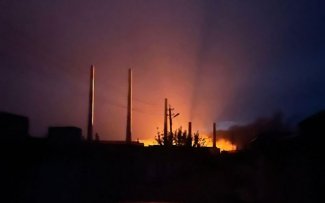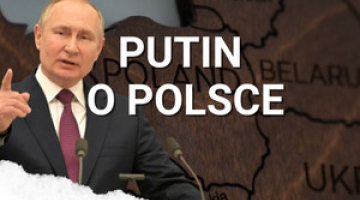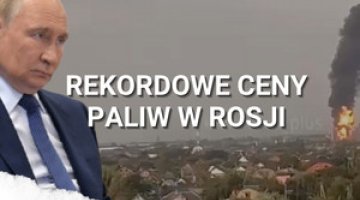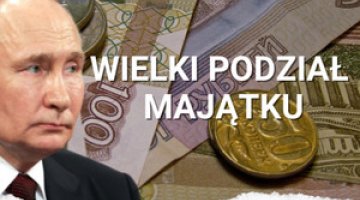Another Russian strike on Ukraine’s energy sector. Day 1041 of the war


Russian forces are continuing their assault in the western part of the Donetsk region with the intention of cutting the last supply routes of the Ukrainians defending in the Kurakhove and Velyka Novosilka areas. According to some sources, this has already happened in the latter location, with supplies only possible via dirt roads from Vremivka, one of the three villages remaining under Ukrainian control (including Velyka Novosilka). Fighting has moved onto the western part of Kurakhove and, according to local reports, Russia has entered the area of the disused thermal power station located there. To the west of the town, another salient has formed, with three villages remaining in the possession of the defenders, including the decisive village of Ulakly (Russia holds positions 2 km south of this village). Russia has also significantly increased the controlled area north-west of Kurakhove and south of Pokrovsk, however, this has not affected the overall situation.
Toretsk and Chasiv Yar are still arenas of heavy clashes. The Russians have deepened their flanking of the former from the west, but in view of the situation in the city this is of little significance to the fighting taking place there. On the other hand, Russia has made significant progress in Chasiv Yar – it has entered its western part. However, the entire south of the town remains under Ukrainian control, and supplies arrive through it. Russian forces recorded some gains north and south of Kupiansk and in the Kursk region, but this does not significantly change the situation. Minor adjustments to the line of contact in favour of either side also occurred in other directions.

On 25 December, there was another massive attack on Ukraine’s energy infrastructure. Damage to facilities was confirmed in Kharkiv Oblast (some sources say that the Zmiyev thermal power plant was among the targets hit) and Dnipropetrovsk, Ivano-Frankivsk (Burshtyn TPP), Kirovohrad and Poltava oblasts. Damage was also reported from Kyiv, Sumy and Zhytomyr oblasts. According to Ukrenergo, as a result of the impact, power cuts for customers were periodically extended to up to 12 hours a day, and its supply was also reduced for business and industry. Emergency outages in Kirovohrad Oblast also occurred the following day, while in Dnipropetrovsk, Poltava and Sumy oblasts the situation was still not stabilised on 29 December.
Particularly severe damage to infrastructure is thought to have taken place in and around Kharkiv, where, according to local data, 12 Russian rockets hit a power station, boiler houses and other facilities. Half a million residents were cut off from heating; this was partially restored by 29 December. In total, Russia was said to have used 78 missiles and 106 drones, of which Ukraine claimed to have downed 59 and 54 respectively (with the remaining 52 drones locally lost).
Before and after the massed rocket attack, Russia continued to make point-blank strikes on the enemy’s rear. Rockets hit Kryvyi Rih (24 December) and Zaporizhzhia (26 December), and rockets and drones hit Mykolaiv (28 December), among others. Excluding 25 December, a total of 184 strike drones and nine missiles are thought to have been used by the Russians between the evening of 23 December and the morning of 30 December. The Ukrainian Air Force Command reported that 114 drones were shot down, with 68 locally lost.

On 26 December, a Shahed drone storage, maintenance and repair depot was allegedly destroyed in an attack on Oryol Oblast, the Ukrainian General Staff reported two days later. According to other sources, continued attacks by Ukrainian drones on the border regions of the Russian Federation between 24 and 29 December had no serious effect. Only the strikes on Vladikavkaz and Grozny on 25 December were more widely publicised. In the former city, falling debris allegedly caused a fire in a shopping centre, while in the latter, Russian air defence repelling the attack damaged an Azerbaijani passenger plane. (See ‘Azerbaijani plane crash: Moscow under pressure from Baku’).

On 29 December, Defence Minister Rustem Umerov announced the distribution of 150 million euros given to Kyiv by Denmark, France and Lithuania to finance the Ukrainian arms industry. The €111 million from Copenhagen will be used to purchase armaments and the €10 million from Vilnius will be used to develop the industry. Umerov did not elaborate on what the €29 million from the French grant would be spent on in order “to strengthen Ukraine’s security and defence”. The six-month training of Ukrainian pilots and maintenance of Mirage 2000-5F fighters has ended in France.
On 30 December, US President Joe Biden announced nearly $2.5 billion in military aid to Kyiv. $1.25bn of this is from the presidential drawdown authority (PDA) and would cover equipment delivered from US Army depots, while $1.22bn is from the Ukraine Security Assistance Initiative (USAI) and would go towards industrial procurement. Two days earlier, the Associated Press reported that the PDA package would include HAWK air defence systems and missiles for previously shipped anti-aircraft weapons (including Stinger) and 155 mm and 105 mm calibre artillery munitions. Greece intends to deliver 24 Sea Sparrow anti-aircraft missiles as well as artillery ammunition and other equipment, the online edition of the daily Kathimerini revealed on 28 December. A day later, Latvian Defence Minister Andris Sprūds reported that a batch of more than 1,000 drones of various types had been prepared for delivery to Kyiv.
On 23 December, the German government updated the list of arms and military equipment transferred to Ukraine. It added, among others, 15 Leopard 1A5 tanks, two Gepard self-propelled anti-aircraft guns, one PzH 2000 self-propelled howitzer, 30 MRAP armoured vehicles, one IRIS-T SLM and IRIS-T SLS air defence system each (the two TRML-4D radars intended for them were listed separately), two launchers for the Patriot system, 68 reconnaissance drones (30 Vector, 24 Heidrun and 14 Hornet XR), as well as 52,000. 155 mm artillery ammunition, and 105 mm tank cartridges, 65,000 35 mm rounds for the Gepard guns and AIM-9L/I Sidewinder air-to-air missiles.

On 23 December, President Volodymyr Zelensky stated that, according to preliminary estimates, the number of North Korean dead and wounded in the Kursk region already exceeds 3,000. He added that there is a risk that North Korea will send additional troops and military equipment. On 27 December, US National Security Council spokesman John Kirby stated that North Korean losses had reached 1,000 killed and wounded over the past week. He indicated that the country’s soldiers have been indoctrinated to the point that, in order to avoid being taken prisoner, they are committing suicide, most likely out of fear of reprisals against their families in North Korea.
On 28 December, the Ukrainian government’s National Resistance Center reported that in the temporarily occupied territories, the Russians had included technical classes on the assembly of drones for the needs of the aggressor’s army in school curricula. They have already approved a programme to expand these classes to 2030.

On 24 December, the Kyiv government simplified the purchase of drones and electronic warfare (EW) means produced in Ukraine. The regulatory changes will allow unit commanders to acquire tactical-level drones and EW means without the bureaucratic burden of coordinating with the General Staff and other military administrations. Units will be able to join agreements concluded by the Defence Procurement Agency and the State Special Communications Service, which will enable them to receive equipment more quickly at competitive prices.
Also on 24 December, the Ukrainian defence ministry asked the parliamentary committee on national security, defence and intelligence to postpone until 18 March 2025 work on a draft law on the conditions for the demobilisation of soldiers during martial law. The draft did not receive the approval of the General Staff. It argued that, if enacted, the estimated number of soldiers who would be entitled to be discharged from service would be 108,000 (including 14,000 officers) and, if they were discharged at the same time, this would lead to a significant reduction in the manning of combat units. The proposal indicates that the Ministry of Defence has drafted its own bill defining the procedure and conditions for dismissal from service of military personnel of certain categories during martial law. The document envisages, among other things, the establishment of new norms for discharge from service and the rotation of troops: those who have served continuously for 36 months and during that time have taken part in hostilities for at least 18 months are to be guaranteed a referral for rehabilitation for up to two months, after which they will be granted an additional single paid leave of 30 to 90 days.
On 27 December, Commander-in-Chief of the Armed Forces of Ukraine Oleksandr Syrskyi provided assurances that the military authorities are working to further extend the training of the mobilised to two months. After completion, soldiers will undergo an adaptation period in brigades, lasting up to two weeks. From 1 November, basic military training was extended from 30 to 45 days at all 27 training centres. In addition to the basics of drone handling and EW measures, the number of shooting exercises has been increased and the number of rounds for the Kalashnikov rifle has been increased from 500 to 870.
Also on 27 December, the commander of the National Guard of Ukraine, Oleksandr Pivnenko, revealed that there are 900 armed groups (including 500 mobile groups) protecting critical infrastructure facilities. He also stated that Ukraine’s Western partners had provided support by supplying electronic equipment to detect and combat enemy drones.
The vetting of businesses applying for the status of entities strategically important to Ukraine’s defence effort is to be completed by 28 February 2025. Obtaining this status will allow a business to guarantee deferments from military service to its employees of mobilisation age. To obtain this status, an entity must meet two conditions: demonstrate the absence of tax debts and provide employees with an average salary of at least 20,000 hryvnias (approximately $500). The last requirement applies only to private businesses.

On 23 December, the operator of Ukraine’s nuclear power plants Energoatom announced that the company’s website had been the target of a five-hour cyberattack. Russian hackers attempted to disrupt the website by sending around 80 million requests to access the site.






